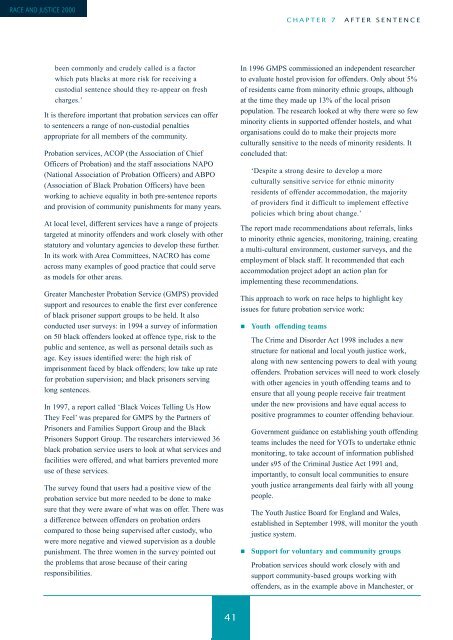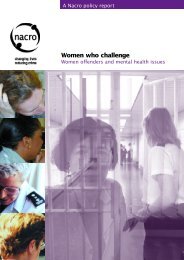Let's get it right: race and justice 2000 - Nacro
Let's get it right: race and justice 2000 - Nacro
Let's get it right: race and justice 2000 - Nacro
- No tags were found...
You also want an ePaper? Increase the reach of your titles
YUMPU automatically turns print PDFs into web optimized ePapers that Google loves.
RACE AND JUSTICE <strong>2000</strong>CHAPTER 7 AFTER SENTENCEbeen commonly <strong>and</strong> crudely called is a factorwhich puts blacks at more risk for receiving acustodial sentence should they re-appear on freshcharges.’It is therefore important that probation services can offerto sentencers a range of non-custodial penaltiesappropriate for all members of the commun<strong>it</strong>y.Probation services, ACOP (the Association of ChiefOfficers of Probation) <strong>and</strong> the staff associations NAPO(National Association of Probation Officers) <strong>and</strong> ABPO(Association of Black Probation Officers) have beenworking to achieve equal<strong>it</strong>y in both pre-sentence reports<strong>and</strong> provision of commun<strong>it</strong>y punishments for many years.At local level, different services have a range of projectstar<strong>get</strong>ed at minor<strong>it</strong>y offenders <strong>and</strong> work closely w<strong>it</strong>h otherstatutory <strong>and</strong> voluntary agencies to develop these further.In <strong>it</strong>s work w<strong>it</strong>h Area Comm<strong>it</strong>tees, NACRO has comeacross many examples of good practice that could serveas models for other areas.Greater Manchester Probation Service (GMPS) providedsupport <strong>and</strong> resources to enable the first ever conferenceof black prisoner support groups to be held. It alsoconducted user surveys: in 1994 a survey of informationon 50 black offenders looked at offence type, risk to thepublic <strong>and</strong> sentence, as well as personal details such asage. Key issues identified were: the high risk ofimprisonment faced by black offenders; low take up ratefor probation supervision; <strong>and</strong> black prisoners servinglong sentences.In 1997, a report called ‘Black Voices Telling Us HowThey Feel’ was prepared for GMPS by the Partners ofPrisoners <strong>and</strong> Families Support Group <strong>and</strong> the BlackPrisoners Support Group. The researchers interviewed 36black probation service users to look at what services <strong>and</strong>facil<strong>it</strong>ies were offered, <strong>and</strong> what barriers prevented moreuse of these services.The survey found that users had a pos<strong>it</strong>ive view of theprobation service but more needed to be done to makesure that they were aware of what was on offer. There wasa difference between offenders on probation orderscompared to those being supervised after custody, whowere more negative <strong>and</strong> viewed supervision as a doublepunishment. The three women in the survey pointed outthe problems that arose because of their caringresponsibil<strong>it</strong>ies.In 1996 GMPS commissioned an independent researcherto evaluate hostel provision for offenders. Only about 5%of residents came from minor<strong>it</strong>y ethnic groups, althoughat the time they made up 13% of the local prisonpopulation. The research looked at why there were so fewminor<strong>it</strong>y clients in supported offender hostels, <strong>and</strong> whatorganisations could do to make their projects moreculturally sens<strong>it</strong>ive to the needs of minor<strong>it</strong>y residents. Itconcluded that:‘Desp<strong>it</strong>e a strong desire to develop a moreculturally sens<strong>it</strong>ive service for ethnic minor<strong>it</strong>yresidents of offender accommodation, the major<strong>it</strong>yof providers find <strong>it</strong> difficult to implement effectivepolicies which bring about change.’The report made recommendations about referrals, linksto minor<strong>it</strong>y ethnic agencies, mon<strong>it</strong>oring, training, creatinga multi-cultural environment, customer surveys, <strong>and</strong> theemployment of black staff. It recommended that eachaccommodation project adopt an action plan forimplementing these recommendations.This approach to work on <strong>race</strong> helps to highlight keyissues for future probation service work:Youth offending teamsThe Crime <strong>and</strong> Disorder Act 1998 includes a newstructure for national <strong>and</strong> local youth <strong>justice</strong> work,along w<strong>it</strong>h new sentencing powers to deal w<strong>it</strong>h youngoffenders. Probation services will need to work closelyw<strong>it</strong>h other agencies in youth offending teams <strong>and</strong> toensure that all young people receive fair treatmentunder the new provisions <strong>and</strong> have equal access topos<strong>it</strong>ive programmes to counter offending behaviour.Government guidance on establishing youth offendingteams includes the need for YOTs to undertake ethnicmon<strong>it</strong>oring, to take account of information publishedunder s95 of the Criminal Justice Act 1991 <strong>and</strong>,importantly, to consult local commun<strong>it</strong>ies to ensureyouth <strong>justice</strong> arrangements deal fairly w<strong>it</strong>h all youngpeople.The Youth Justice Board for Engl<strong>and</strong> <strong>and</strong> Wales,established in September 1998, will mon<strong>it</strong>or the youth<strong>justice</strong> system.Support for voluntary <strong>and</strong> commun<strong>it</strong>y groupsProbation services should work closely w<strong>it</strong>h <strong>and</strong>support commun<strong>it</strong>y-based groups working w<strong>it</strong>hoffenders, as in the example above in Manchester, or41

















